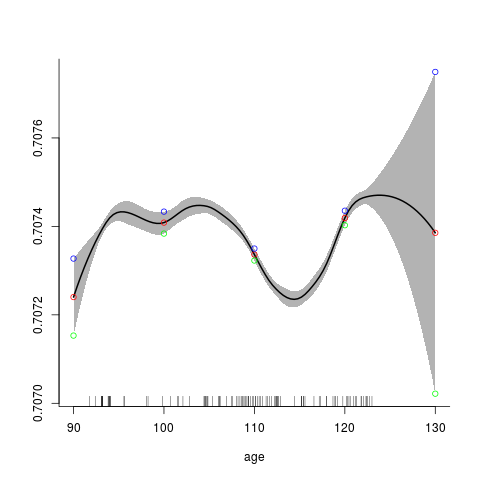Supported by Dr. Osamu Ogasawara and  providing providing  . . |
|
Last data update: 2014.03.03 |
Semiparametric regression prediction.DescriptionTakes a fitted Usage## S3 method for class 'spm' predict(object,newdata,se,...) Arguments
DetailsTakes a fitted ValueIf se=FALSE then a vector of predictions at ‘newdata’ is returned. If se=TRUE then a list with components named ‘fit’ and ‘se’ is returned. The ‘fit’ component contains the predictions. The ‘se’ component contains standard error estimates. Author(s)M.P. Wand mwand@uow.edu.au (other contributors listed in SemiPar Users' Manual). ReferencesRuppert, D., Wand, M.P. and Carroll, R.J. (2003) Ganguli, B. and Wand, M.P. (2005) See Also
Exampleslibrary(SemiPar) data(fossil) attach(fossil) fit <- spm(strontium.ratio~f(age)) newdata.age <- data.frame(age=c(90,100,110,120,130)) preds <- predict(fit,newdata=newdata.age,se=TRUE) print(preds) plot(fit,xlim=c(90,130)) points(unlist(newdata.age),preds$fit,col="red") points(unlist(newdata.age),preds$fit+2*preds$se,col="blue") points(unlist(newdata.age),preds$fit-2*preds$se,col="green") Results
R version 3.3.1 (2016-06-21) -- "Bug in Your Hair"
Copyright (C) 2016 The R Foundation for Statistical Computing
Platform: x86_64-pc-linux-gnu (64-bit)
R is free software and comes with ABSOLUTELY NO WARRANTY.
You are welcome to redistribute it under certain conditions.
Type 'license()' or 'licence()' for distribution details.
R is a collaborative project with many contributors.
Type 'contributors()' for more information and
'citation()' on how to cite R or R packages in publications.
Type 'demo()' for some demos, 'help()' for on-line help, or
'help.start()' for an HTML browser interface to help.
Type 'q()' to quit R.
> library(SemiPar)
> png(filename="/home/ddbj/snapshot/RGM3/R_CC/result/SemiPar/predict.spm.Rd_%03d_medium.png", width=480, height=480)
> ### Name: predict.spm
> ### Title: Semiparametric regression prediction.
> ### Aliases: predict.spm
> ### Keywords: models smooth regression
>
> ### ** Examples
>
> library(SemiPar)
> data(fossil)
> attach(fossil)
> fit <- spm(strontium.ratio~f(age))
> newdata.age <- data.frame(age=c(90,100,110,120,130))
> preds <- predict(fit,newdata=newdata.age,se=TRUE)
> print(preds)
$fit
[1] 0.7072402 0.7074085 0.7073363 0.7074190 0.7073855
$se
[1] 4.352895e-05 1.241325e-05 6.764932e-06 8.208831e-06 1.818758e-04
>
> plot(fit,xlim=c(90,130))
> points(unlist(newdata.age),preds$fit,col="red")
> points(unlist(newdata.age),preds$fit+2*preds$se,col="blue")
> points(unlist(newdata.age),preds$fit-2*preds$se,col="green")
>
>
>
>
>
> dev.off()
null device
1
>
|
